Bandhavgarh Tiger Reserve, Bandhavgarh, MP (IUCN category II national park)
– “In any other Park, You are lucky if you see a tiger. In Bandhavgarh, you are unlucky if you don’t see (at least) one.“
Introduction
The reserve named after the highest hill Bandhavgarh (807 m) in the centre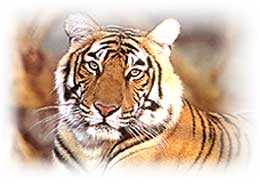 of it, falls between the Vindhyan hill range and the eastern flank of Satpura hill range and is located in Umaria District of Madhya Pradesh.
of it, falls between the Vindhyan hill range and the eastern flank of Satpura hill range and is located in Umaria District of Madhya Pradesh.
Rivers Johilla and Son flowing on the boundary on the eastern side, river Umrar passing through western fringes and the Bandhavgarh hill, which is visible from as far as 30 km, are some of the landmarks of the Reserve.
The four main zones of the national park are Tala, Magdhi, Khitauli, and Panpatta. Tala is the richest zone in terms of biodiversity, mainly tigers. Together, these four ranges comprise the ‘Core’ of the Bandhavgarh Tiger Reserve constituting a total area of 694 km². The buffer zone is spread over the forest divisions of Umaria and Katni and totals another 437 km². The legal status as a national park dates back to 1968, but was limited only to the present Tala range for a considerable length of time. In 1993 the present scheme of things was put in place.
Location & Geographical Details:
District: Umaria, Madhya Pradesh, India
Core Zone: 624 sq kms.
Buffer Zone: 537 sq. kms.
Longitude: 80 47’15” to 81 11′ 45 E
Latitude: 23 30′ 12 to 23 45′ 45 N
Altitude: 440mts to 810mts above sea level.
Rainfall: Avg. 1170mm approx.
Temperature: Min. 2C- Max. 44 C.
Road distance from nearest Cities and places is as per the table: ^ Top
|
City
|
Distance
|
|
Umaria
|
37 Kms.
|
|
Katni
|
100 Kms.
|
|
Rewa
|
120 Kms.
|
|
Jabalpur
|
190 Kms.
|
|
Khajuraho
|
250 Kms.
|
|
Kanha National Park
|
260 Kms.
|
|
Panna National Park
|
210 Kms.
|
|
Pench National Park
|
390 Kms.
|
|
Satpura National Park
|
440 Kms.
|
|
Nagpur
|
480 Kms.
|
|
Varanasi
|
410 Kms.
|
|
Raipur
|
480Kms.
|
Nearest Railway Stations: Katni( KTE) , Jabalpur (JBP), Rewa(REWA) , Satna (STA) . These railway stations are well connected with all major cities and tourist destinations of the country.
Forest Type:
Moist Peninsular low level Sal: 3C/C2a
Wet Gangetic moist mixed deciduous forest: 3C/C3a
Season:-
Monsoon- mid June to September
Winter- November to mid-February
Summer- mid March to mid June
Best Time to Visit:-
The park is open from 1st October till 30th June
Conservation History
Bandhavgarh has been an excellent habitat of tiger and is known for the highest density of tigers in the world. Considering the importance and potentiality of the National park, it was included in the Project Tiger Network in 1993. The adjoining Panpatha Sanctuary too was declared as a part of the Reserve.
Archeological History
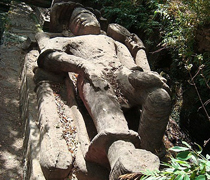 Mythologically the Bandhavgarh fort was built by Lord Ram for his brother Laxman, during Ramayan period. The name Bandhavgarh apparantly comes from the fact that Bandhav means brother and Garh means Fort. There are a number of man made caves (35) in Bandhavgarh with inscriptions and carvings, which date back between about 129-168 A.D. Statues of various incarnations of Lord Vishnu, which were carved out of single rocks are found in the fort. “Sheshshaiya” the statue of lord Vishnu in reclining pose is the biggest of all and attracts every tourist. These statues date back to 10-11th Century A.D.
Mythologically the Bandhavgarh fort was built by Lord Ram for his brother Laxman, during Ramayan period. The name Bandhavgarh apparantly comes from the fact that Bandhav means brother and Garh means Fort. There are a number of man made caves (35) in Bandhavgarh with inscriptions and carvings, which date back between about 129-168 A.D. Statues of various incarnations of Lord Vishnu, which were carved out of single rocks are found in the fort. “Sheshshaiya” the statue of lord Vishnu in reclining pose is the biggest of all and attracts every tourist. These statues date back to 10-11th Century A.D.
The Bandhavgarh Fort is a great masterpiece of “Treta Yuga(त्रेता युग )” (one of the ages of mankind in Hinduism) that has been discovered to be the most ancient masterpiece dating before the Christ period through the archeological surveys .
The tourists hitting to Bandhargarh National Park makes a must visit to the fort to find the written proofs of the Bharihas and Vakatak dynasties who ruled over the land in and around the Bandhavgarh region. This region also unveils the history to find the major dynasties that ruled the Bandhavgarh regions including Sengars, the Kalchuris and the Baghels. Out of all the Baghels were believed to rule the regions for the longer period.
Major Attractions
- Watching Bengal Tigers : The main attraction of Bandhavgarh national park is watching Bengal tigers. Bandhavgarh has the highest density of Bengal tigers known in the world,
and is home to some famous named individual tigers. Charger, a tiger so named because of his habit of charging at elephants and tourists (whom he nonetheless did not harm), was the first healthy male known to be living in Bandhavgarh since the 1990s. A female known as Sita, who once appeared on the cover of National Geographic and is considered the most photographed tiger in the world was also to be found in Bandhavgarh for many years. Almost all the tigers of Bandhavgarh today are descendants of Sita and Charger. Their daughter Mohini, son Langru and B2 also maintained their tradition for frequent sighting and moving close to tourist jeeps. A zone has been named after Charger as Charger’s Place. Charger died in year 2000 after ruling the park for a decade. ^ Top
- Bandhavgarh Fort : The fort is located on the highest plateau(height approx 810 meters) and it was once used as Royal fort of Rewa rulers. Mythology says that this fort was prepared by Lord Ram for his brother Lakshman to keep an eye on Lanka , hence name Bandhavgarh. The fort is visible from all parts of the park and from this heigh, all parts of the park are also visible. This is one of the most visited places by tourist. However, only remains of the Fort are now present and one has to get permission from authorities to visit the fort.
- Ancient Caves of Bandhavgarh : There are 39 caves in the bandhavgarh hill and in surrounding hills spread over an area of about 5 kms.The oldest caves appear to be as ancient as the first century A.D. Several caves carry ancient scripts and rock paintings on them.
^ Top
Major Flora
Sal, Saja, Dhauda, Tendu, Arjun, Aonla, Pals, Salai, Bhirra, Khamer, Dhaman, Mango, Jamun, Bamboo, etc.
Major Fauna
Main Species
Mammals:
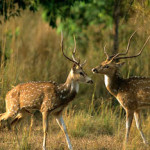 Spotted deer or Chital, Sambar, Barking deer or Muntjac, Chausinga or Four-horned antilope, Nilgai or Blue bull, Indian Gazel or chinkara and Tiger, Leopard, wild dog or Dhole, Wolf, Scavangers consists of Hyena, jackal, Wild boar, Sloth bear, Common Langur, Rhesus monkey etc.
Spotted deer or Chital, Sambar, Barking deer or Muntjac, Chausinga or Four-horned antilope, Nilgai or Blue bull, Indian Gazel or chinkara and Tiger, Leopard, wild dog or Dhole, Wolf, Scavangers consists of Hyena, jackal, Wild boar, Sloth bear, Common Langur, Rhesus monkey etc..
Bird Species: 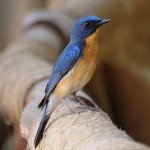
Reptiles
Cobras, Kraits, Vipers and Python
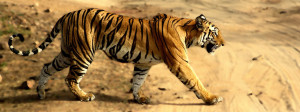
You must be logged in to post a comment.